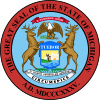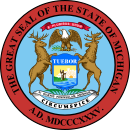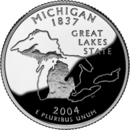The Michigan Portal  Michigan (/ˈmɪʃɪɡən/ ⓘ MISH-ig-ən) is a peninsular state in the Great Lakes region of the Upper Midwestern United States. It shares water and land boundaries with Minnesota to the northwest, Wisconsin to the west, Indiana and Illinois to the southwest, Ohio to the southeast, and the Canadian province of Ontario to the east, northeast and north. With a population of 10.14 million and an area of 96,716 sq mi (250,490 km2), Michigan is the 10th-largest state by population, the 11th-largest by area, and the largest by total area east of the Mississippi River. The state capital is Lansing, while its most populous city is Detroit. The Metro Detroit region in Southeast Michigan is among the nation's most populous and largest metropolitan economies. Other important metropolitan areas include Grand Rapids, Flint, Ann Arbor, Kalamazoo, the Tri-Cities, and Muskegon. Michigan consists of two peninsulas: the heavily forested Upper Peninsula (commonly called "the U.P."), which juts eastward from northern Wisconsin, and the more populated Lower Peninsula, stretching north from Ohio and Indiana. The peninsulas are separated by the Straits of Mackinac, which connects Lake Michigan and Lake Huron, and are linked by the 5-mile-long Mackinac Bridge along Interstate 75. Bordering four of the five Great Lakes and Lake St. Clair, Michigan has the longest freshwater coastline of any U.S. political subdivision, measuring 3,288 miles. The state ranks second behind Alaska in water coverage by square miles and first in percentage, with approximately 42%, and it also contains 64,980 inland lakes and ponds. In the 17th century, French explorers claimed the Great Lakes region for New France, though the area had largely been inhabited for thousands of years by Indigenous peoples such as the Ojibwe, Odawa, Potawatomi, and Wyandot. French settlers and Métis established forts and settlements. Some people contend that the region’s name is derived from the Ojibwe word ᒥᓯᑲᒥ (mishigami), meaning "large water" or "large lake". While others say that it comes from the Mishiiken Tribe of Mackinac Island, also called Michinemackinawgo by Ottawa historian Andrew Blackbird , whose surrounding lands were referred to as Mishiiken-imakinakom, later shortened to Michilimackinac. After France's defeat in the French and Indian War in 1762, the area came under British control and later the U.S. following the Treaty of Paris (1783), though control remained disputed with Indigenous tribes until treaties between 1795 and 1842. The area was part of the larger Northwest Territory; the Michigan Territory was organized in 1805. Michigan was admitted as the 26th state on January 26, 1837, entering as a free state and quickly developing into an industrial and trade hub that attracted European immigrants, particularly from Finland, Macedonia, and the Netherlands. In the 1930s, migration from Appalachia and the Great Migration of Black Southerners further shaped the state, especially in Metro Detroit. Michigan has a diversified economy with a gross state product of $711.481 billion as of Q3 2024, ranking 14th among the 50 states. Although the state has developed a diverse economy, in the early 20th century it became widely known as the center of the U.S. automotive industry, which developed as a major national economic force. It is home to the country's three major automobile companies (whose headquarters are all in Metro Detroit). Once exploited for logging and mining, today the sparsely populated Upper Peninsula is important for tourism because of its abundance of natural resources. The Lower Peninsula is a center of manufacturing, forestry, agriculture, services, and high-tech industry. (Full article...) Entries here consist of Good and Featured articles, which meet a core set of high editorial standards.
The Ford Piquette Avenue Plant is a former factory located within the Milwaukee Junction area of Detroit, Michigan, in the United States. Built in 1904, it was the second center of automobile production for the Ford Motor Company, after the Ford Mack Avenue Plant. At the Piquette Avenue Plant, the company created and first produced the Ford Model T, the car credited with initiating the mass use of automobiles in the United States. Prior to the Model T, several other car models were assembled at the factory. Early experiments using a moving assembly line to make cars were also conducted there. It was also the first factory where more than 100 cars were assembled in one day. While it was headquartered at the Piquette Avenue Plant, Ford Motor Company became the biggest U.S.-based automaker, and it would remain so until the mid-1920s. The factory was used by the company until 1910, when its car production activity was relocated to the new, larger Highland Park Ford Plant. Studebaker bought the factory in 1911, using it to assemble cars until 1933. The building was sold in 1936, going through a series of owners for the rest of the 20th century before becoming a museum in 2001. The Piquette Avenue Plant is the oldest purpose-built automotive factory building open to the public. The museum, which was visited by over 31,000 people in 2018, has exhibits that primarily focus on the beginning of the United States automotive industry. The building was added to the National Register of Historic Places in 2002, became a Michigan State Historic Site in 2003, and was designated a National Historic Landmark in 2006. (Full article...) Selected picture - Campus Martius Park is a re-established park in downtown Detroit, Michigan. After the fire of 1805, Campus Martius (from the Latin for Field of Mars, where Roman heroes walked) was the focal point of judge Augustus Woodward's plans to rebuild the city. Did you know -
Related portalsSelected article -Joseph McGinty Nichol (born August 9, 1968), known professionally as McG, is an American director, producer, and former record producer. McG began his career in the music industry, directing music videos and producing various albums. He later rose to prominence with his debut theatrically released narrative feature, Charlie's Angels, which had the highest-grossing opening weekend for a directorial debut at the time. Since then, he has directed several other films, including Terminator Salvation, This Means War, and The Babysitter. On television, McG co-created Fastlane with John McNamara and executive produced The O.C., Supernatural, and Chuck. (Full article...) Selected biography -Brandon Ricardo Minor (born July 24, 1988) is a former American football running back. He played college football at Michigan from 2006 to 2009. He was signed by the Chicago Bears as an undrafted free agent in 2010, but was released during the final cuts and played on practice squads in 2010 for the New Orleans Saints and Indianapolis Colts. At Michigan, Minor finished second on the team in rushing both as a freshman and sophomore and led the team in rushing both as a junior and senior. As a junior, he was an honorable mention All-Big Ten Conference selection by the coaches. He had previously been ranked as the number one high school football fullback in the nation, according to Rivals.com. (Full article...) General imagesThe following are images from various Michigan-related articles on Wikipedia.
TopicsCategoriesSymbols
Lists
Related pagesWikimediaThe following Wikimedia Foundation sister projects provide more on this subject:
Things you can doDiscover Wikipedia using portals | ||||||||||||||||||||||||||||||||||||

















































































